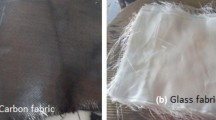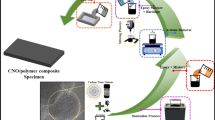Abstract
This paper presents the machining efficiency evaluation of the glass fiber reinforced polymer (GFRP) composites modified by multiwall carbon nanotube (MWCNT). The milling experimentations were performed according to Taguchi-based experimental design. The three distinct machining constraints, such as spindle speed (S), feed rate (F), depth of cut (D), and wt% of MWCNT, are controlled to achieve the desired machining performances. A comparatively new multi-criteria decision-making technique (MCDM) is used by the combined compromise solution (CoCoSo) module for optimal parametric conditions. Analysis of variance (ANOVA) technique on CoCoSo assessment score is applied to determine the variance and adequacy level of variables used during machining of the nanocomposite. The experimental result shows that the depth of cut (D) and MWCNT wt% are found to be the most significant input parametric constraints, while spindle speed (S) and feed (F) obtained to be insignificant. The experimentation also revealed that the proposed CoCoSo optimization approach is a very effective tool for multi-objective optimization of milling parameters.
Access this chapter
Tax calculation will be finalised at checkout
Purchases are for personal use only
Similar content being viewed by others
References
Panchagnula KK, Kuppan P (2019) Improvement in the mechanical properties of neat GFRPs with multi-walled CNTs. In: J Mater Res Technol. 366–376. Brazilian Metallurgical, Materials and Mining Association
Navagally RR (2017) Composite materials-history, types, fabrication techniques, advantages, and applications. Int J Mech Prod Eng 82–87
Pallapothu H, Kumar A, Laxminarayana P (2020) Micro drilling of glass fibre reinforced polymer composites. Mater Today Proc 1–5. https://doi.org/10.1016/j.matpr.2020.01.545
Anand G, Alagumurthi N, Elansezhian R, Palanikumar K, Venkateshwaran N (2018) Investigation of drilling parameters on hybrid polymer composites using grey relational analysis, regression, fuzzy logic, and ANN models. J Brazilian Soc Mech Sci Eng 40:1–20. https://doi.org/10.1007/s40430-018-1137-1
Kumar DS, Shukla MJ, Mahato KK, Rathore DK, RKP, BCR (2015) Preparation and mechanical properties of graphene/carbon fiber-reinforced hierarchical polymer composites. In: Effect of post-curing on thermal and mechanical behavior of GFRP composites. p 75
Garcia EJ, Wardle BL, Hart AJ, Yamamoto N (2008) Fabrication and multifunctional properties of a hybrid laminate with aligned carbon nanotubes grown in situ. 68:2034–2041. https://doi.org/10.1016/j.compscitech.2008.02.028
Kharwar PK, Verma RK, Mandal NK, Mondal AK (2020) Swarm intelligence integrated approach for experimental investigation in milling of multiwall carbon nanotube/polymer nanocomposites. Arch Mech Eng 67. https://doi.org/10.24425/ame.2020.131698
Yu Q, Alvarez NT, Miller P, Malik R, Haase MR, Schulz M, Shanov V, Zhu X (2016) Mechanical strength improvements of carbon nanotube threads through epoxy cross-linking. Materials (Basel) 9:1–12. https://doi.org/10.3390/ma9020068
Meenakshi R, Suresh P (2020) WEDM of Cu/WC/SiC composites: development and machining parameters using artificial immune system. J Exp Nanosci 15:12–25. https://doi.org/10.1080/17458080.2019.1708331
Ramulu M, Kramlich J (2004) Machining of fiber reinforced composites: review of environmental and health effects. Int J Environ Conscious Des Manuf 11:1–19
Raj SSR, Dhas JER, Jesuthanam CP (2020) Challenges on machining characteristics of natural fiber-reinforced composites–a review. J Reinf Plast Compos. https://doi.org/10.1177/0731684420940773
Kumar J, Verma RK (2020) Experimental investigation for machinability aspects of graphene oxide/carbon fiber reinforced polymer nanocomposites and predictive modeling using hybrid approach. Def Technol. https://doi.org/10.1016/j.dt.2020.09.009
Shahabaz SM, Shetty N, Shetty SD, Sharma SS (2020) Surface roughness analysis in the drilling of carbon fiber/epoxy composite laminates using hybrid Taguchi-Response experimental design. Mater Res Express 7. https://doi.org/10.1088/2053-1591/ab6198
Zhang X, Yu T, Zhao J (2020) An analytical approach on stochastic model for cutting force prediction in milling ceramic matrix composites. Int J Mech Sci 168:105314. https://doi.org/10.1016/j.ijmecsci.2019.105314
Mondal N, Mandal S, Mandal MC (2020) FPA based optimization of drilling burr using regression analysis and ANN model. Meas J Int Meas Confed 152:107327. https://doi.org/10.1016/j.measurement.2019.107327
Gokulkumar S, Thyla PR, ArunRamnath R, Karthi N (2020) Acoustical analysis and drilling process optimization of camellia sinensis/ananas comosus/GFRP/epoxy composites by TOPSIS for indoor applications. J Nat Fibers 1–18. https://doi.org/10.1080/15440478.2020.1726240
Barua A, Jeet S, Bagal DK, Satapathy P, Agrawal, PK (2019) Evaluation of mechanical behavior of hybrid natural fiber reinforced nano sic particles composite using hybrid Taguchi-Cocoso method. Int J Innov Technol Explor Eng 8:3341–3345. https://doi.org/10.35940/ijitee.J1232.0881019
Thakur RK, Singh KK, Sharma D (2019) Modeling and optimization of surface roughness in end milling of graphene/epoxy nanocomposite. Mater Today Proc 19:302–306. https://doi.org/10.1016/j.matpr.2019.07.213
Arun GK, Sreenivas N, Reddy KB, Krishna Reddy KS, Shashi Kumar ME, Pramod R (2018) Investigation on mechanical properties of graphene oxide reinforced GFRP. IOP Conf Ser Mater Sci Eng 310. https://doi.org/10.1088/1757-899X/310/1/012158
Davim JP, Reis P, António CC (2004) A study on milling of glass fiber reinforced plastics manufactured by hand-lay up using statistical analysis (ANOVA). Compos Struct 64:493–500. https://doi.org/10.1016/j.compstruct.2003.09.054
Rajesh Mathivanan N, Mahesh BS, Anup Shetty H (2016) An experimental investigation on the process parameters influencing machining forces during milling of carbon and glass fiber laminates. Meas J Int Meas Confed 91:39–45. https://doi.org/10.1016/j.measurement.2016.04.077
Parida AK, Bhuyan RK, Routara BC (2014) Multiple characteristics optimization in machining of GFRP composites using grey relational analysis. Int J Ind Eng Comput 5:511–520. https://doi.org/10.5267/j.ijiec.2014.8.001
Asghar A, Raman AAA, Daud WMAW (2014) A comparison of central composite design and Taguchi method for optimizing fenton process. Sci World J 2014. https://doi.org/10.1155/2014/869120
Acknowledgements
The authors would also like to thank o/O DC (Handicrafts), Ministry of Textiles, Government of India, New Delhi, INDIA, for their kind assistance to perform this study.
Funding
This research work is financially supported by o/O DC (Handicrafts), Ministry of Textiles, Govt. of INDIA, Under Project ID: K-12012/4/19/2020–21/R and D/ST.
Author information
Authors and Affiliations
Corresponding author
Editor information
Editors and Affiliations
Rights and permissions
Copyright information
© 2023 The Author(s), under exclusive license to Springer Nature Singapore Pte Ltd.
About this paper
Cite this paper
Kumar, K., Verma, R.K. (2023). Combined Compromise Solution for Machining Performance Optimization of Modified Polymer Composite. In: Dixit, U.S., Kanthababu, M., Ramesh Babu, A., Udhayakumar, S. (eds) Advances in Forming, Machining and Automation. Lecture Notes in Mechanical Engineering. Springer, Singapore. https://doi.org/10.1007/978-981-19-3866-5_17
Download citation
DOI: https://doi.org/10.1007/978-981-19-3866-5_17
Published:
Publisher Name: Springer, Singapore
Print ISBN: 978-981-19-3865-8
Online ISBN: 978-981-19-3866-5
eBook Packages: EngineeringEngineering (R0)




